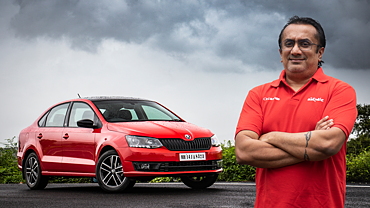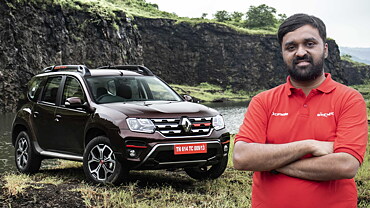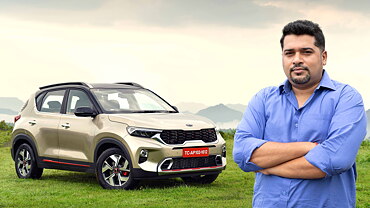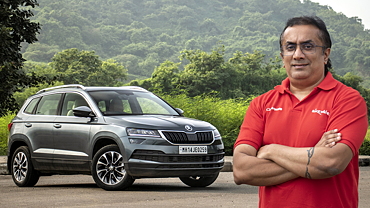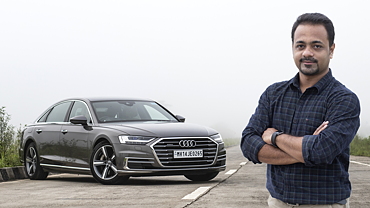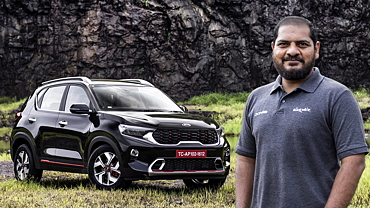
Honda Siel Cars India have always had a presence at the premium end of the market. They started off small, with the City, but soon moved on to bigger things and never looked back. However, in today’s car market, downsizing is where the profits lie, and Honda isn’t immune to the trend. Enter the Jazz, small by Honda India’s standards, but large in every other sense. The Jazz has also been priced at a price which other hatchbacks can only dream of – will this B+ segment car with C+ pricing work?

The Jazz has an impressive front end – a nose that is dominated by the big H and flanked by very Japanese-looking large,  swept-back headlamps. The bonnet has two longitudinal creases that run to the base of the windscreen from the badge. Oval fog lamps that now are present on the new City and Civic as well are housed in the bumper and look ever so slightly out of place with the rest of the nose, which is sharp and angular. In profile, the Jazz has a very MPV-ish shape thanks to the cab-forward design, with short front and rear overhangs. It’s a mini-Innova, if you will, with a lot of sharp creases to take the eye away from the bland profile. The rear three-quarters has nothing special to note, the angle showing off a very generic shape. The rear view is the most unflattering view, the wide ‘hips’ tapering towards the top. Look carefully and you’ll notice the spoiler at the top of the tailgate that houses the high-mounted stop lamp.
swept-back headlamps. The bonnet has two longitudinal creases that run to the base of the windscreen from the badge. Oval fog lamps that now are present on the new City and Civic as well are housed in the bumper and look ever so slightly out of place with the rest of the nose, which is sharp and angular. In profile, the Jazz has a very MPV-ish shape thanks to the cab-forward design, with short front and rear overhangs. It’s a mini-Innova, if you will, with a lot of sharp creases to take the eye away from the bland profile. The rear three-quarters has nothing special to note, the angle showing off a very generic shape. The rear view is the most unflattering view, the wide ‘hips’ tapering towards the top. Look carefully and you’ll notice the spoiler at the top of the tailgate that houses the high-mounted stop lamp.
Paint quality is of a high standard, as we've come to expect from a Honda product. Six colours are available to the Jazz buyer: deep sapphire blue, sherbet blue, habanero red, alabaster silver, taffeta white and crystal black pearl. The shots you see on these pages are of a sherbet blue car, the other shade being deep sapphire blue. Shutlines on the Jazz are small and consistent.

This is where the Jazz scores in spades. It’s got loads of space in both rows. Quality abounds, both in the plastics and fabrics used. The Jazz will take a little getting used to the first time one gets in, because the base of the windscreen is so far  away. This can also make it a problem while parking in confined spaces, since it makes it quite hard to judge where the front corners of the car are. The large glass area makes the cabin feel bigger than it really is, despite the grey fabrics used. A comfortable driving position is easily achieved, thanks to the adjustment that is available on the driver’s seat. The steering wheel is sporty and has controls for the audio system on it, which adds to the ‘expensive’ feeling in the car. However, it doesn’t telescope, which we’d have liked – after all, hatchbacks like the Fabia and i20 offer a steering wheel that telescopes, and this goes a long way in making the driver comfortable over long journeys. What will make tall drivers really uncomfortable is the point to which the flowing lines of the dashboard converge to on the bottom right side – this point will dig into your left knee if you’re about six feet tall. What drivers will like are the front quarter glasses, which are large enough to be functional, although in the short time that the car was with us, we didn’t get comfortable enough to make out where the nose was. The other occupants of the car will be extremely comfortable, what with the excellent knee- and headroom. Boot space is
away. This can also make it a problem while parking in confined spaces, since it makes it quite hard to judge where the front corners of the car are. The large glass area makes the cabin feel bigger than it really is, despite the grey fabrics used. A comfortable driving position is easily achieved, thanks to the adjustment that is available on the driver’s seat. The steering wheel is sporty and has controls for the audio system on it, which adds to the ‘expensive’ feeling in the car. However, it doesn’t telescope, which we’d have liked – after all, hatchbacks like the Fabia and i20 offer a steering wheel that telescopes, and this goes a long way in making the driver comfortable over long journeys. What will make tall drivers really uncomfortable is the point to which the flowing lines of the dashboard converge to on the bottom right side – this point will dig into your left knee if you’re about six feet tall. What drivers will like are the front quarter glasses, which are large enough to be functional, although in the short time that the car was with us, we didn’t get comfortable enough to make out where the nose was. The other occupants of the car will be extremely comfortable, what with the excellent knee- and headroom. Boot space is  extremely good for a hatchback, but if you find it isn’t enough for an airport run, the ‘magic seats’, as Honda has branded them, will have you playing games with the number of combinations you can have to make space for your luggage. They split 60:40 and not only fold flat to the boot floor level, the seat base will also fold upwards if you need to stack things vertically. The left rear seat base also has a small storage space if you need to squirrel away valuables. There are a total of ten cupholders in the car, according to Honda, but the ones that impressed us the most were the ones placed under the air-conditioning vents that keep your drinks cool. We also liked the little storage space in the boot on the right side – it’s perfect for storing small things that would otherwise roll around in the boot.
extremely good for a hatchback, but if you find it isn’t enough for an airport run, the ‘magic seats’, as Honda has branded them, will have you playing games with the number of combinations you can have to make space for your luggage. They split 60:40 and not only fold flat to the boot floor level, the seat base will also fold upwards if you need to stack things vertically. The left rear seat base also has a small storage space if you need to squirrel away valuables. There are a total of ten cupholders in the car, according to Honda, but the ones that impressed us the most were the ones placed under the air-conditioning vents that keep your drinks cool. We also liked the little storage space in the boot on the right side – it’s perfect for storing small things that would otherwise roll around in the boot.
The quality of the plastics and fabrics is top notch, with fit and finish of a similarly high order. The orange-on-orange dials are easy to read, and the white LCD multifunction display with the real-time fuel consumption indicator encourages the driver to drive with a light right foot. There is no temperature gauge, but ‘hot’ and ‘cold’ indicators are present in the instrument gauge cluster. Start the car up on a cold morning, and the blue ‘cold’ light will stay on until the engine is warm enough, after which it will switch off. The door locks puzzled us – the individual locks are very hard to operate. In an otherwise ergonomically correct interior, this is one feature that seems to have been overlooked.

Engine
To take advantage of the duty cut for cars with engines displacing less than 1200cc, Honda has offered a 1198cc petrol engine instead of the 1340cc unit it offers in the European Jazz. This motor produces almost 90bhp and 110Nm, which sounds adequate, but it struggles below 2000rpm. Honda has used a single overhead camshaft instead of its standard dual overhead cams, but even this engine maximises low-end torque by shutting off one intake valve at low revs. The engine revs freely to 6600rpm. During our tests, the Jazz did a 0-100kph run in 14.7 seconds. This motor is surprisingly vocal for a Honda powerplant – it is refined, but we’ve come to expect the silent treatment from a Honda engine during normal usage. The American-spec Fit (which is what the Jazz is called there) has a 1.5-litre engine with 117bhp and 144Nm of torque. What’s more, this engine is mated to an automatic gearbox, which would have made a lot of sense for a practical car.
Drivetrain
The gear knob is well designed, with short, positive throws and a golf-ball top. This is a good thing, since you have to change gears frequently in the Jazz due to the lack of poke below 2000rpm. The in-gear times of 5.3sec from 30-50kph in third gear and 7.9sec in fourth are par for the segment, proving that the car is not a slouch – it is quite drivable and simply masks speed. Overtaking on the highway also will not be too much trouble, as shown by the 50-70kph time of 10.0sec in top gear.
Fuel efficiency
The Jazz lives up to its reputation as a frugal sipper, giving us 12.3kpl in normal usage and dropping to 9.4kpl during testing, our harshest driving cycle. The 42-litre tank should therefore give the user an effective range of a little over 500km.

The Jazz rides well at low speeds, the soft suspension helping cushion the occupants from road imperfections. Despite being such a large car, it does give a feeling of lightness, which is typical of Japanese cars. Up speed and things get better – you get the feeling that that chassis could handle more power, with the limiting factor being the tyres, which are the first to protest when you go corner-carving. Push the car to really high speeds, however, and the rear gets bouncy, especially when unladen.
The steering wheel of the Jazz is light and accurate, making light work of heavy traffic. This ease of use robs it of feel when pressing on through a corner, but the accuracy more than makes up for it. Ground clearance is not an issue with this car – it is practical in a number of ways, just like Honda tells you in their campaigns.

Braking
The Jazz’s brakes are equipped with ABS, which makes them really good in extreme situations. They’re light and progressive under normal circumstances – but we’d have liked a little more bite from them.
Tyres
The Honda Jazz comes equipped with Michelin Energy XM1 tyres of the size 175/65 R15, which is the same size as that of the Honda City. The car rides well on this rubber and grips well once the tyres have warmed up. The XM1s are quiet and promise better fuel efficiency through lower rolling resistance.
Safety
The Jazz comes loaded with safety features in its base model as well. The car has anti-lock brakes and dual airbags across the range. Another important safety feature is the fuel tank of the car that is located under the driver's seat so that it is insulated from the engine and rear end of the car. This ensures that it will not rupture in case of a collision. Honda’s G-CON chassis construction ensures optimum crash safety.

The Jazz’s sticker price of Rs 7.5 lakh, ex-showroom is a new high for hatchbacks in our country, barring the Optra SR-V. However, people are taking to the Jazz like a child to a puddle on a rainy day, and Honda seems to have got it right with the combination of quality and after-sales service. We’d like more power with our Jazz, though.
1198cc, 4 cylinder in-line petrol. 90bhp@6200rpm and 110Nm@4800rpm View specifications
Speedo Error
|
| Gear | Speed (kph@rpm) |
|---|---|
| 1st | 45.4 @6600 |
| 2nd | 83.7@6600 |
| 3rd | 127.6@6600 |
| 4th | 165.6@6500 |
| 5th | - |
| 6th | - |
| Top Speed* | 165.6kph |
|---|---|
| 0-60kph | 6.2sec |
| 0-100kph | 14.7sec |
| Quarter Mile (402m) | [email protected] |
| Braking 80-0kph | 3.1sec@35m |
| 30-50kph in 3rd | 5.3sec |
| 30-50kph in 4th | 7.9sec |
| 50-70kph in 5th | 10.0sec |
| City | Highway | Overall | Worst | |
|---|---|---|---|---|
| Mileage (kpl) | 12.4 | 9.4 |
